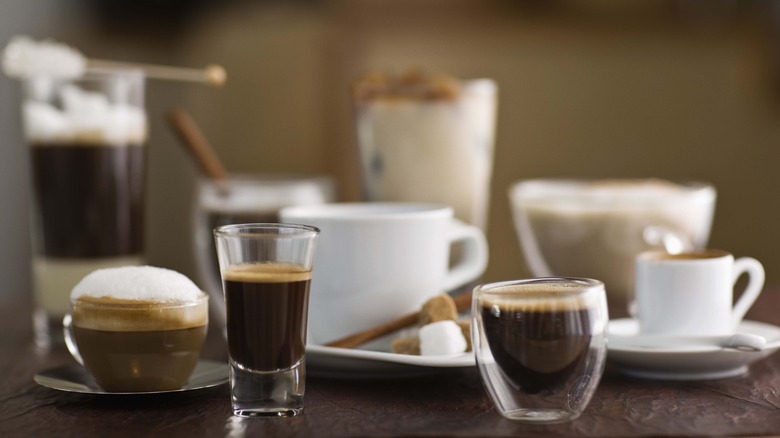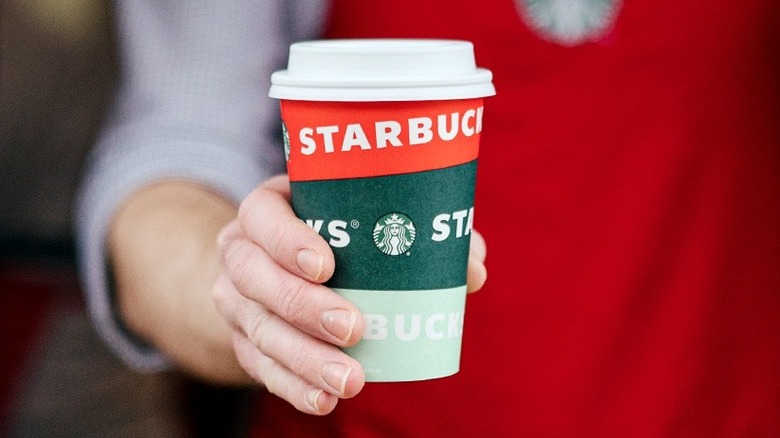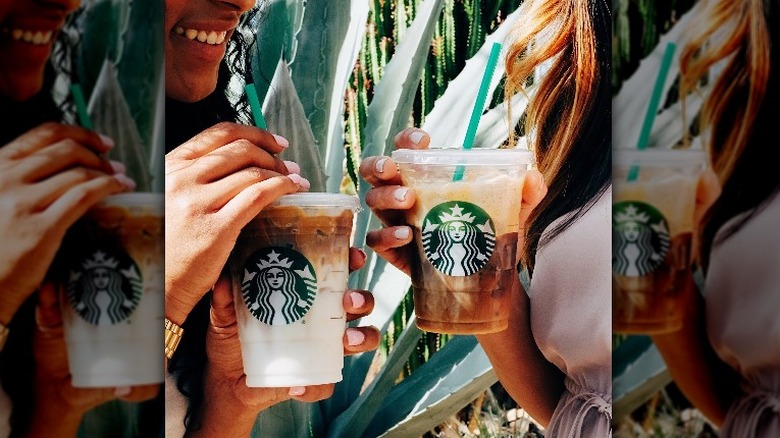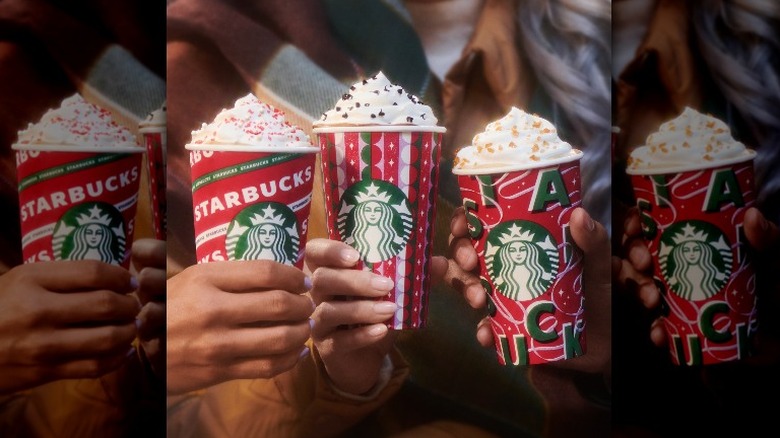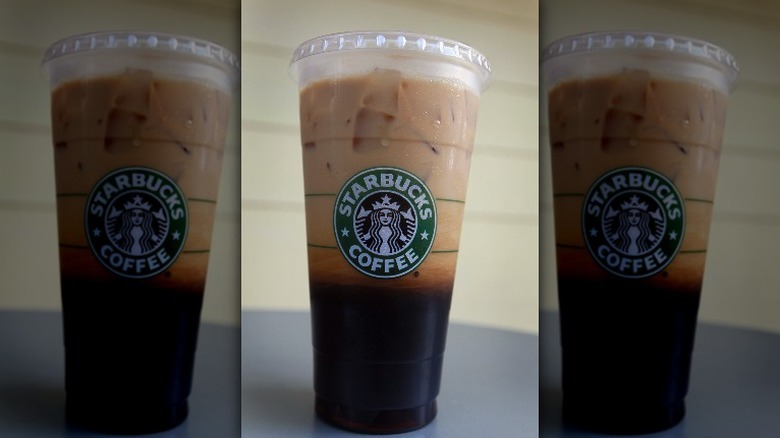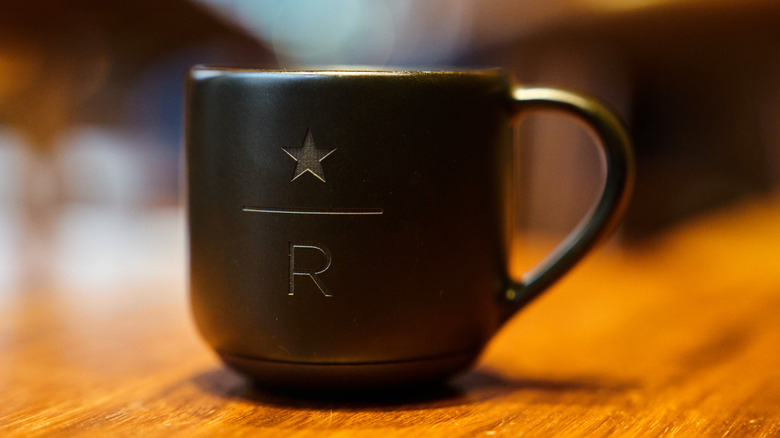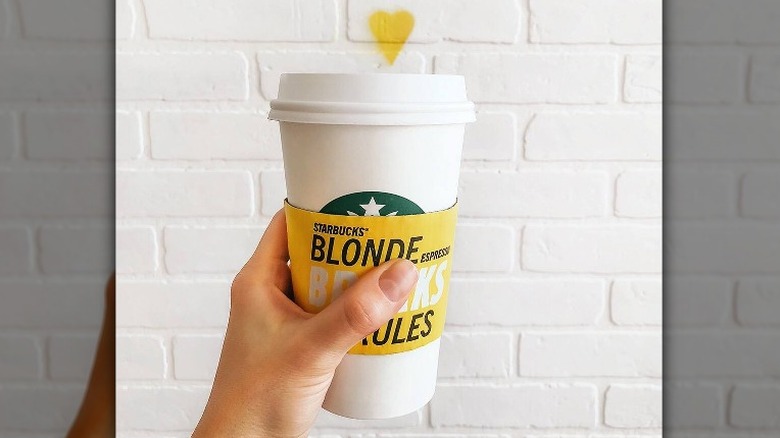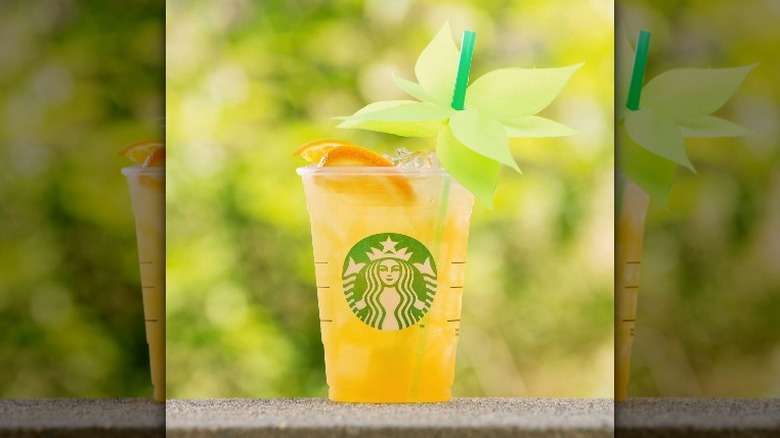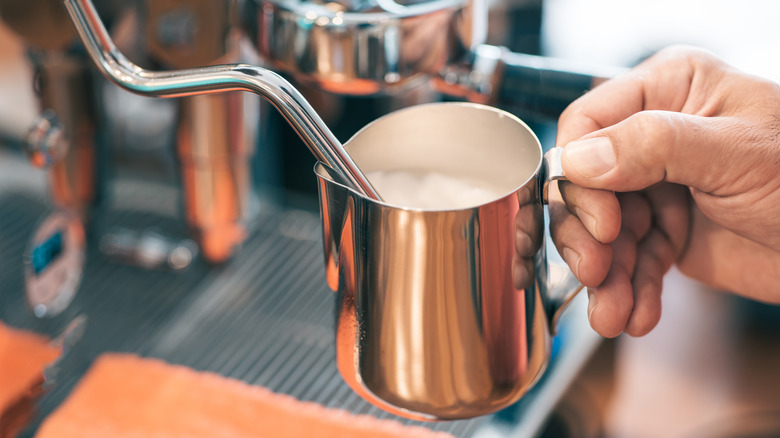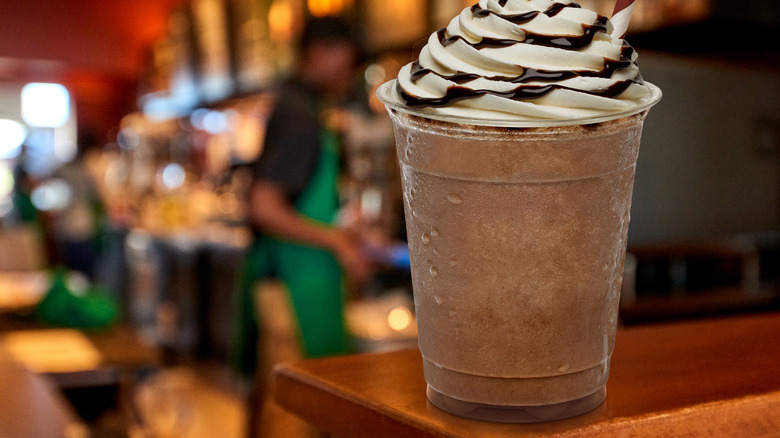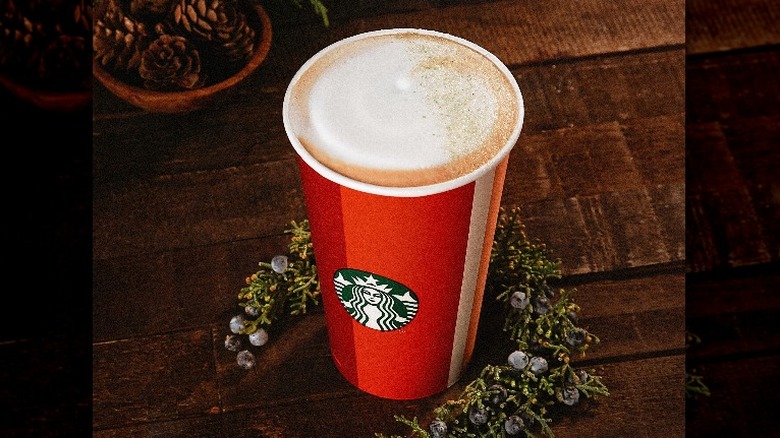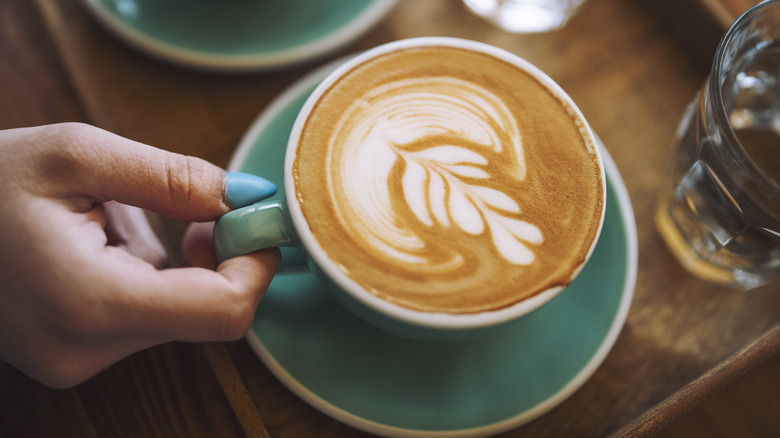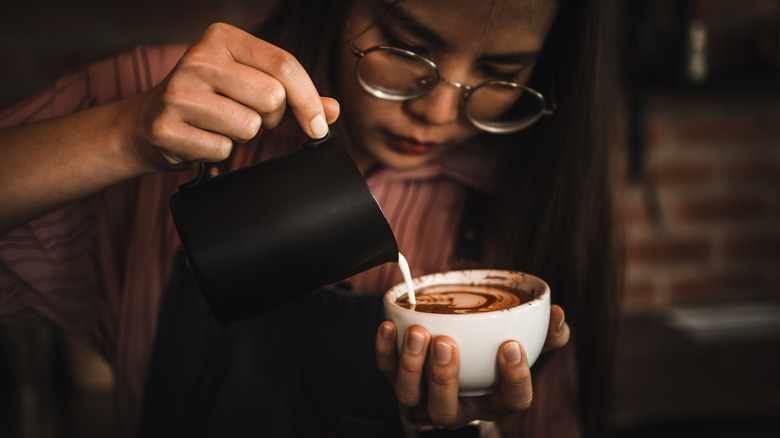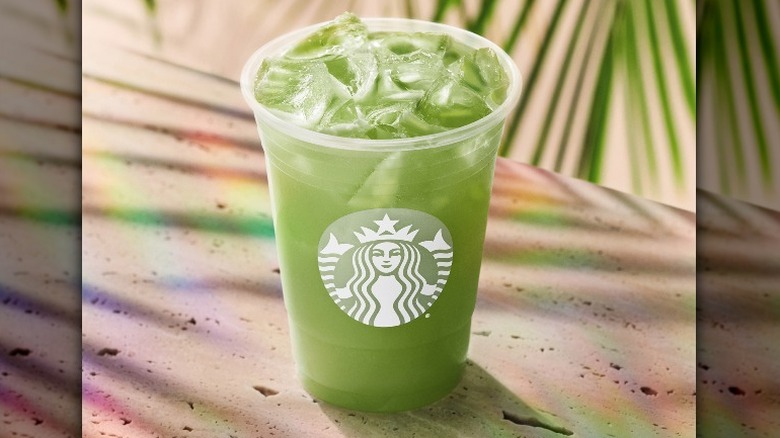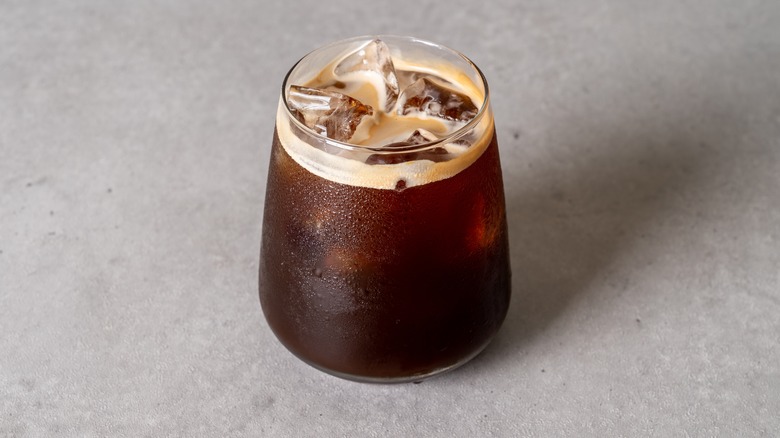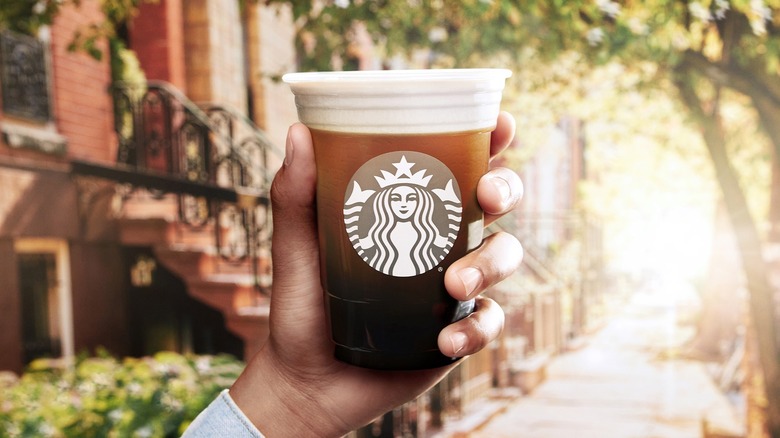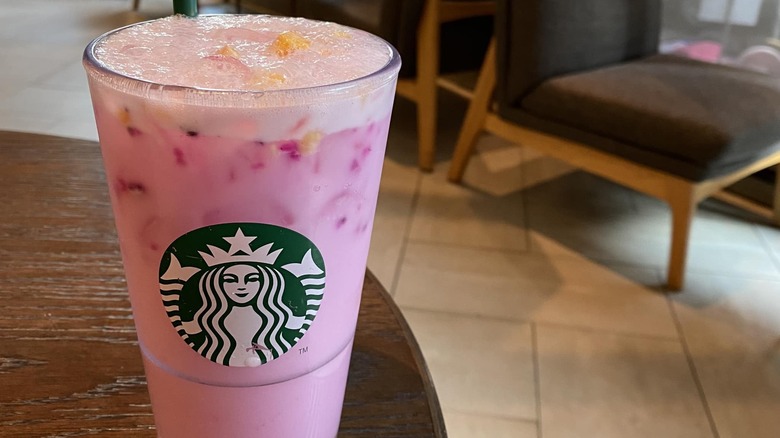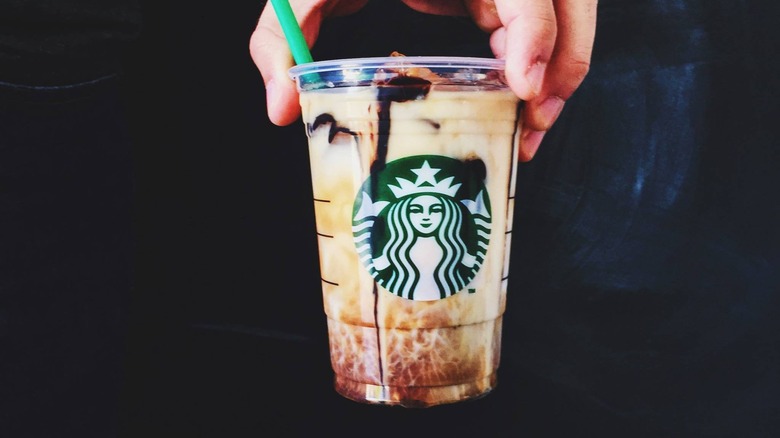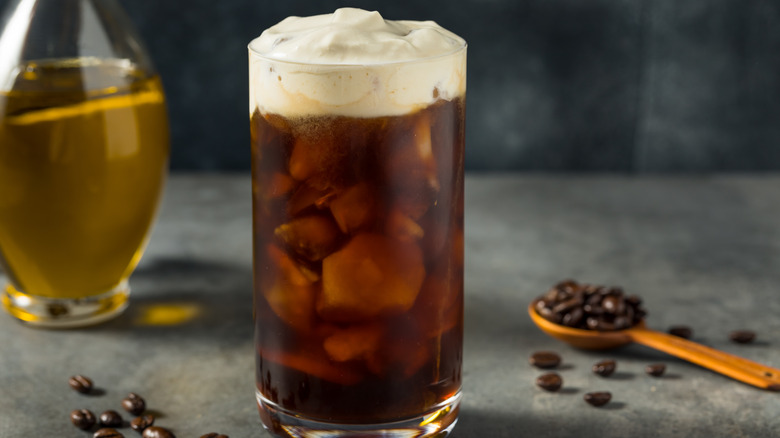18 Essential Starbucks Terms You Need To Know
Back in the early 2000s, Dunkin' launched a commercial that portrayed a group of customers perplexedly studying a coffee shop menu. The accompanying jingle humorously suggested that the menu was penned in "Fritalian," an imaginary fusion of French and Italian. Dunkin' then offered itself as a coffee shop that speaks simple English. Although not explicitly stated, the commercial seemed like a mockery of Starbucks and its menu.
Even almost 20 years later, many people still find Starbucks' naming conventions for its beverages quite puzzling, and some struggle to distinguish between the different types of drinks the coffee Siren offers. Learning the brand's distinctive lingo can feel akin to mastering a foreign language for those who do not regularly visit Starbucks. However, the key Starbucks terms are more complex than they might initially seem, and with a little practice, they can be quickly learned. Before you know it, you'll be conversing fluently in Starbucks speak and comfortably ordering your drinks from the menu like a pro.
Tall
One of the first aspects to understand about Starbucks is that its cup size names differ from that of other coffee shops. When you want a small beverage at Starbucks, you request a "tall" drink. This will provide you with a 12-ounce serving of your chosen coffee or tea delight. Both iced and hot versions of the "tall" are 12 ounces.
This sizing system can sometimes bewilder new Starbucks patrons. The term "tall" typically suggests something quite lengthy, such as a tall person. It might seem counterintuitive that a "tall" equates to a small size at Starbucks. If the "tall" size is too much, you can request an even smaller size, known as a "short" of 8 ounces. Although it's not a standard option across the board on the menu, Starbucks can usually accommodate this request. However, it's important to note that we haven't observed a "short" option for iced drinks (probably because the ice would take up most of the volume in the cup).
Grande
If you've ever used the Starbucks app to place an order, you might have observed that the default size for any drink is listed as a "grande." This particular term is part of Starbucks' unique beverage sizing terminology, equivalent to what most would consider a "medium." Regardless of whether the beverage is hot or cold, a "grande" at Starbucks measures 16 ounces.
The term "grande" originates from Spanish, where it translates to "large" in English. Despite its meaning, it's worth noting that a "grande" is not the largest size available at Starbucks — it's merely one step larger than the smaller "tall" size. This discrepancy between the literal translation and its application in Starbucks' context can sometimes lead to confusion among customers and lead them to order medium rather than working with the company's lingo.
Venti
For a long time, the largest drink you could order at Starbucks was referred to as a "venti." The word "venti" is derived from Italian and translates into English as "20." This terminology correlates with Starbucks' sizing, as a hot venti beverage is served in a 20-ounce cup. However, it's important to note that a venti iced drink is actually 24 ounces due to the additional volume occupied by ice.
In most scenarios, a venti is the largest size you can order at Starbucks, particularly for Frappuccinos and many other handcrafted drinks. However, there are exceptions. For instance, iced teas, iced coffees, cold brews, and refreshers follow slightly different size guidelines and can be served in even larger sizes. Yet, for most beverages, the venti remains the maximum size. It's also worth noting that a venti fits the size of the large iced cups that Starbucks offers.
Trenta
For those instances when 24 ounces of your favored iced coffee just isn't sufficient, Starbucks offers an even larger size called the "trenta." Exclusive to iced beverages, the trenta size is available for a select range of iced drinks: teas, lemonades, refreshers, coffee, and cold brew.
Interestingly, the trenta option can also cater to customers who enjoy their drinks extra chilled. If you wish to order an iced venti drink but prefer additional ice, requiring more space, you can request it in a trenta cup. The trenta size is indeed substantial, offering a voluminous 31 ounces of your chosen beverage. This size, derived from the Italian word for "30," is a fitting choice for those with a strong affection for their iced drinks or those needing a generous caffeine boost to power through their day.
Espresso
Espresso is distinct from regular coffee, and understanding this difference involves diving into the nuances of coffee preparation. Espresso is essentially a concentrated version of coffee, created by forcing highly pressurized hot water through very finely ground coffee beans. The outcome is a small, intense serving of coffee, often referred to as a "shot." This term is commonly used in coffeehouses; for instance, when you request additional espresso in your latte at Starbucks, it is typically counted as an extra "shot" of coffee.
For espresso, the coffee beans are ground extremely fine, almost to a powder-like consistency. This allows for the rapid, high-pressure extraction that is characteristic of espresso preparation. On the other hand, drip coffee involves a coarser grind and a slower, gravity-assisted brewing process. Whenever you order a coffee drink that is not cold brew, iced coffee, or drip coffee, you'll be getting espresso in your drink. Of course, espresso is not exclusive to Starbucks, but knowing what it is will help you make an informed decision when ordering off the menu.
Blonde
In 2018, Starbucks customers witnessed a sweeter addition to its espresso menu. Prior to this, Starbucks exclusively offered its Signature Roast for espresso-based drinks, characterized by its bold, strong flavor profile, often perceived as slightly bitter. However, the introduction of the Blonde Espresso Roast marked a departure from this tradition.
The Blonde Espresso Roast is noticeably smoother than the Signature Roast. With its subtle sweetness, it offers a softer, more mellow espresso experience and is an excellent choice for those who prefer a less pronounced coffee bite in their drinks.
The good news is that you can order a Blonde Roast for any espresso-based drink on the menu. Switching it up is as simple as requesting it from your barista or selecting the espresso type in the Starbucks app. This option has made it possible for customers to customize their drinks further, aligning them with their personal taste preferences. There are even several Starbucks drinks that have blonde espresso roast as the default and it makes for an especially smoother iced coffee.
Refresher
For some people, the distinctive taste of tea may not be appealing, and the robust profile of coffee may prove too intense. Yet, these individuals often still crave a caffeine pick-me-up. This is precisely the niche that Starbucks Refreshers have filled wonderfully. This innovative line of beverages made its debut in the summer of 2012, offering a middle ground for those in search of a milder caffeine kick.
While the range of Starbucks Refresher has evolved and expanded over the years, even sparking trends such as the popular "Pink Drink," the core concept remains unchanged. Refreshers serve as a delightful and, as the name suggests, refreshing alternative to traditional coffee and tea beverages. They provide a gentle caffeine boost without the pronounced flavor profile typically associated with coffee.
Interestingly, the energy boost derived from a Starbucks Refresher originates from un-roasted green coffee beans. This allows the caffeine content without the characteristic coffee taste, thereby broadening the appeal of these drinks.
Breve
By default, Starbucks prepares most of its handcrafted espresso beverages using 2% milk. This choice offers a balanced richness that creates a smooth and delightful drinking experience for the majority of customers. However, for those who prefer an even richer taste and texture, Starbucks offers the option to customize their beverage to be made "breve."
When you request your latte to be made "breve," the barista will use half-and-half instead of 2% milk. This substitution can be made for any handcrafted beverage, whether it's hot or cold. For hot beverages, the half-and-half will be steamed just like the 2% milk would be, while for cold beverages, the barista will replace the cold 2% milk with chilled half-and-half. Simply put, the "breve" style results in a drink that feels and tastes heavier due to the increased fat content of the half-and-half. Yet, it also imparts a creamier texture and a richer taste to the beverage.
Frappuccino
Starbucks Frappuccinos are deliciously blended drinks that come in many different flavors. Especially for new Starbucks fans, learning exactly what a Frappuccino is and how it is different from similar-sounding drinks on the menu is an absolutely essential distinction to make. Otherwise, you may order a drink you didn't intend to.
A Frappuccino is made with either a coffee or a cream base, flavoring, ice, and, often, whipped cream and toppings like drizzled caramel. When made with a coffee base, your Frappuccino will be naturally caffeinated by that coffee. However, when it's made with a cream base, it will typically be non-caffeinated, but there are two notable exceptions to that rule: the Chai Cream Frappuccino and the Matcha Cream Frappuccino. Both of these cream-based Frappuccinos contain caffeine derived from their respective teas. As a result, these cream-based Frappuccinos are caffeinated, but not by coffee.
Latte
Beyond drip coffee, the quintessential latte serves as a testament to Starbucks' mastery of coffee craft. These beverages can be tailored with any syrup that Starbucks has on hand, allowing for almost limitless customization to cater to individual preferences.
A latte and cappuccino share three foundational elements: espresso, steamed milk, and milk foam. For a hot latte, the process begins with a couple of shots of espresso, followed by pouring steamed milk over it. The finishing touch is a light topping of foam added by the barista. If you've chosen any flavoring, it's usually incorporated just before or after the espresso, ensuring the taste is thoroughly blended into the drink.
In contrast, an iced latte's preparation differs slightly due to the absence of steamed milk and, consequently, milk foam. An iced latte is a fusion of espresso, ice, and milk, supplemented with any syrup flavoring of your choice.
Cappuccino
A cappuccino differentiates itself from a latte in the balance of its elements after the initial espresso shot. In a cappuccino, the ratio leans towards a greater volume of foamed milk and less steamed milk when compared to a latte. It's worth noting that cappuccinos are typically served hot, and iced variations are not commonly found.
Traditionally, cappuccinos are not flavored, setting them apart from lattes in terms of customization options. However, the few customization options that do exist for cappuccinos are quite impactful. For instance, if you prefer a milkier cappuccino, you can request it to be "wet," which means the barista will add more steamed milk and less foam. Conversely, if you favor a cappuccino with a greater proportion of foam, you can request it to be "dry." In a dry cappuccino, the weight is predominantly concentrated at the bottom of the cup due to the abundance of light, airy foam at the top. This gives a dry cappuccino a distinctly different feel compared to a latte or even a regular cappuccino.
Misto
If you find the robust flavor of espresso overwhelming yet have a preference for Starbucks' brewed coffee, a Caffè Misto might be your ideal beverage. Similar to a latte in terms of its composition, a Cafè Misto swaps out espresso for freshly brewed coffee, which is then combined with steamed milk. In France, this concoction is referred to as "café au lait."
What makes the Cafè Misto even more appealing is the versatility it offers. With a wide variety of coffees regularly available at Starbucks, you can choose the type of coffee you want to blend with your milk. Further enhancing the customizability, a selection of syrup flavors is available to personalize your Misto to your taste preference. For tea lovers, there's the option of a Tea Misto, which comprises steeped tea and steamed milk. These beverages have been rebranded as Tea Lattes on the menu, but fundamentally, they remain the same beverage.
Matcha
An often overlooked gem in the Starbucks drink lineup is anything made with matcha powder. Matcha shares similarities with green tea, but there are notable differences in cultivation and preparation that result in a unique flavor profile and texture. Both matcha and green tea originate from the same plant; however, matcha plants are cultivated in the shade for a period before harvesting, while green tea plants bask in full sunlight.
When it comes to processing, green tea retains its leaf form, while matcha is finely ground into a delicate, soft powder. The method of preparation also differs: Green tea leaves are steeped in hot water to infuse the flavor, whereas matcha powder is whisked directly into the water, creating a richer and creamier beverage. Starbucks offers the flexibility of adding matcha powder to a variety of drinks but also has a dedicated lineup showcasing its distinct taste. Prominent among these are the Matcha Creme Frappuccino and the iced matcha latte.
Americano
Among the underrated beverages on the Starbucks menu is the Americano, a straightforward yet flavorful drink available in both hot and iced versions. This elegant concoction consists of several shots of espresso harmoniously combined with water.
A hot Americano is made by adding hot water to the espresso, resulting in a drink that is not only rich and robust but also exceptionally hot. Due to the elevated temperature, we highly recommend you either double-cup your drink or ask for a coffee sleeve to ensure a comfortable grip. Some might even find the need for both precautions, given the impressive heat retention of this beverage.
An iced Americano, on the other hand, introduces a refreshing twist to the classic formula. While the espresso remains hot, it is tempered with the inclusion of cold water and ice, making it a perfect choice for warmer days or for those who prefer a cooler caffeine fix.
Nitro
For coffee purists seeking a cold brew unadulterated by sweeteners or milk, nitro-infused cold brew offers an intriguing option. This unique beverage is essentially cold brew coffee infused with little nitrogen bubbles, yielding a smooth texture and a visually appealing cascade effect upon pouring.
Nitro Cold Brew is dispensed from a specialized tap, usually situated at the end of the Starbucks bar. The nitrogen infusion gives the coffee a creamy mouthfeel and a naturally sweet taste, despite the absence of added sugar. It's this delicate balance that distinguishes Nitro Cold Brew and makes it an ideal choice for black coffee aficionados desiring a cold variant.
However, those with a preference for sweeter drinks take note: The Nitro Cold Brew is typically served without additional sweeteners or milk, and, unlike other iced drinks, it's served without ice. This is because these additives can disrupt the beverage's unique composition, diminishing its characteristic creaminess and altering its nuanced flavor profile.
Inclusions
If you've ever savored a Starbucks refresher and noticed the small pieces of freeze-dried fruit floating in your drink, you may have wondered what they're called. These flavorful bits, adding a delightful texture and burst of taste to your beverage, are referred to as "inclusions." Knowing this term can be particularly beneficial when customizing your order. For instance, you can request extra inclusions for an amplified taste or fewer inclusions if you prefer a less fruity touch.
Moreover, if there's a specific type of inclusion you're fond of, like those from the Strawberry Açaí Refresher, you can request these be added to other beverages. For instance, including them in Frappuccinos can provide a visually appealing topping and infuse the drink with vibrant color. Not only do these inclusions add a delicious twist, but they also contribute to the aesthetic appeal of your beverage, making it a feast for both the eyes and the palate.
Sauce
Flavor customization at Starbucks primarily comes in two forms: syrups and sauces. Syrups are typically thinner concoctions, whereas sauces are denser and often incorporate some form of dairy, providing a richer and creamier flavor profile. For instance, flavorings like Pumpkin Spice and White Mocha are sauces. Regular Mocha, despite being a sauce, is actually an exception to the general dairy rule. This chocolatey delight is, interestingly, vegan-friendly, as it's crafted without any milk products, thus offering a delectable choice for those adhering to a vegan diet.
The difference in consistency and ingredients between syrups and sauces leads to variations in the texture and richness of your beverages. Syrups can give a subtle hint of flavor and sweetness without altering the texture of the drink significantly. Conversely, sauces, with their denser composition, can impart a deeper, more robust flavor and a creamier feel.
Oleato
In a relatively recent innovation, Starbucks has introduced a line of Oleato coffee. This unique concoction blends coffee with olive oil, offering an intriguing play of flavors for the adventurous coffee enthusiast. Incorporating olive oil into beverages infuses them with an intriguing depth, creating a novel fusion of flavors.
You can find this fascinating series in three iterations at most Starbucks cafe locations: a Golden Foam Cold Brew, an Iced Shaken Espresso, and a Latte variant. The Golden Foam Cold Brew offers a surprising but delightful marriage of flavors. The Iced Shaken Espresso, combined with the Blonde Espresso Roast and a hint of toffeenut syrup results in a tantalizing fusion of flavors, and the Oleato Latte brings a creamy, velvety texture that olive oil is known for.
